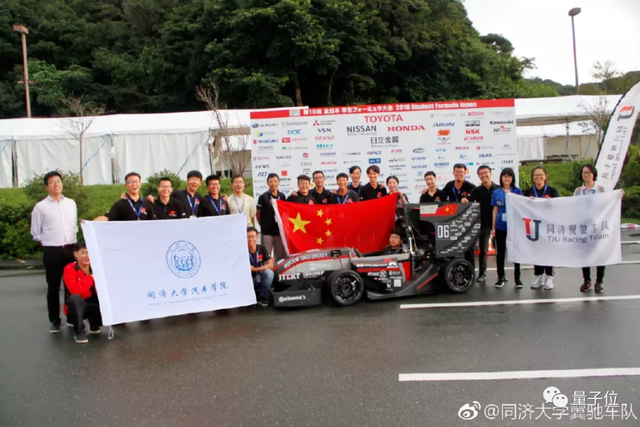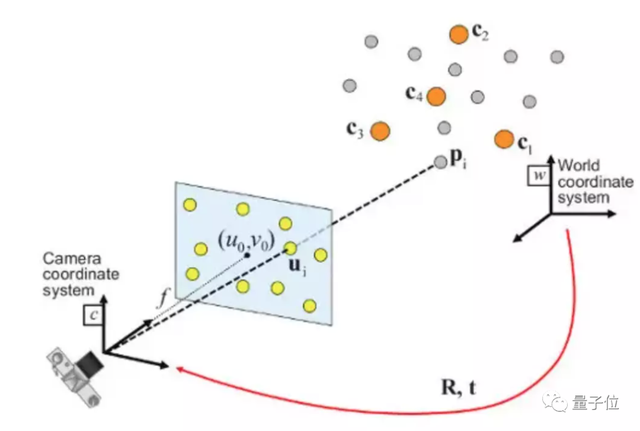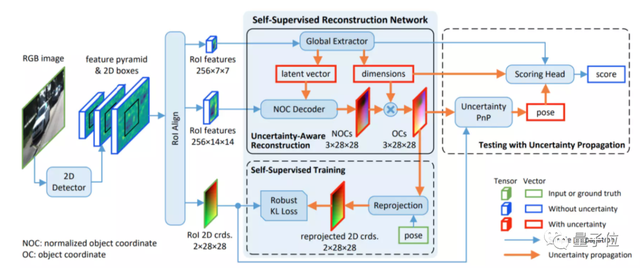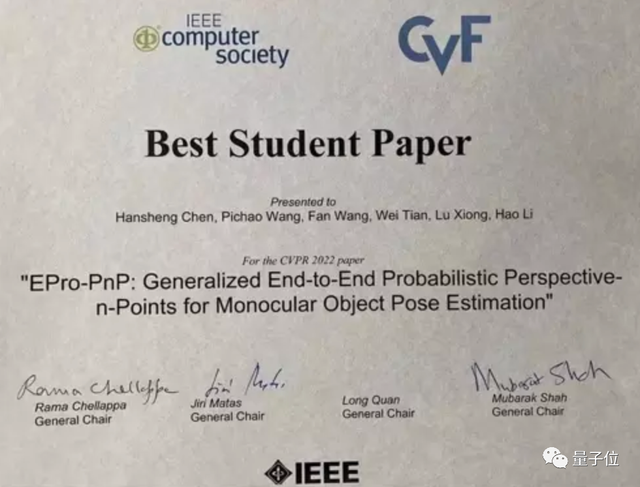He studied cars in Tongji and won the CVPR Best Student Paper Award this year
Author:Quantum Time:2022.06.27
Mengchen Xiaoxiao is from the quantity of the Temple of Temple | Public Account QBITAI
From automotive dynamics "switching" intelligent visual perception, two CVPR papers have been obtained in 3 years.
One of them is the best student thesis award for CVPR papers this year.
The award was awarded for more than 20 times. For the first time this year, it was awarded to students from Chinese universities and defeated another papers of Harvard doctoral students & Google.
This is the real experience of Chen Han Sheng, a second -year master's degree in Tongji University in the second grade of Tongji University, and Chen Han Sheng, an intern of Aliba.

Turn forward, he is also interested in automobile dynamics. He has joined the racing team and dominates the development of air dynamics. In the end, the team won the award in the international competition of college students;
In the first year of study, the paper was selected as CVPR, but because the theory was not sufficient enough, he continued to study in depth, only this year's best student thesis award.
In the exchange with Chen Hansheng, we understand more stories about him.
In the fifth year of undergraduate, transition to autonomous driving
Chen Han Sheng's Tongji Automobile College, the undergraduate is five years.
As soon as he entered the school, he participated in the Tongji Yiqi Team. This is a student society composed of hundreds of people. With the support of schools, colleges, and sponsors, it will be designed, manufactured, and participates in domestic and international competitions every year.
In the fleet, Chen Hansheng is responsible for the development of air dynamics, mainly involving technologies such as simulation computing and curved surface modeling.
He gradually became the backbone of the team, and also helped the team win the best air dynamic award at the 2018 Japanese university student Formula.

In fact, cars and computers are the hobbies that Chen Hansheng has since childhood. He said that he couldn't figure out which one he preferred. In addition, mathematics is also a discipline he has always been interested in.
After the college entrance examination, he also considered a computer major, but he chose a car in the end.
In the year of graduation, he saw a new path that combines these hobbies more closely.
The tide of smart cars and autonomous driving is here.
At that time, the Institute of Intelligent Automobile Research, which was founded shortly after, was also recruiting students. His graduation design chose the direction of autonomous driving.
If you have the opportunity, you want to try new things.

Chen Hansheng joined Professor Xiong Lu's research group to start learning new knowledge. Teacher Xiong Lu will also become his mentor later at the graduate stage.
Xiong Lu is currently the Deputy Director of the New Energy Automobile Engineering Center of Tongji University. He has long been engaged in scientific research on automotive chassis control and distributed driving electric vehicle dynamics control.
During the graduate stage, Chen Hansheng also had a deputy director and assistant professor of the School of Automobile College of Tongji University. He mainly studied the environmental target perception technology and trajectory prediction technology of intelligent driving.
Will it be very stressful to turn to the direction and learn cross -disciplinary discipline? Chen Hansheng thought it would not be tired for him, but the collision in the two fields always made him more inspiration.
The year of graduation was the most comfortable and easiest year over the years. I completely learned new knowledge and had a great sense of gain.
If you are not satisfied with alchemy, you must understand the theory, and you can get 2 CVPR in a row
At the study, Teacher Tian Wei arranged the direction of the topic for him to add probability and uncertainty in the traditional model.
Chen Hansheng combined it with the problem of 3D objects he was interested in and published his first CVPR.
Although he won the meeting, Chen Han Sheng still felt worse.
This article is designed according to experience. Although the model is good, I don't understand why he is good, and it is impossible to prove that this method is optimal with mathematical theory.

Compared with the biggest breakthrough point compared with the previous papers, Chen Hansheng believed that "solving problems from theory."
We unify all methods and put them in a large framework. Then I found a more common and effective method from this framework, and the second paper was born.
The two CVPR papers of Chen Hansheng are specifically studied the problem of 3D object positions through a single 2D image.
For humans, through a 2D photo, the general position of each object in the judgment is very simple.
But for computers, this is a relatively complicated problem. As the following cars below, there is no sense of distance/near:

Therefore, how to make the computer society estimate the position and orientation of 3D objects through 2D photos, it becomes a problem that needs to be solved, such as autonomous driving (using a camera to estimate vehicle location), AR (judge virtual object distance) and other fields must be used. arrive:

However, the two existing types of solutions have certain defects in geometric reasoning and deep learning.
Geometric reasoning, the most common is PNP (Perspective-N-Point) algorithm, which specifically refers Internal reference to reverse the position of the camera.
In essence, it is to find the coordinate system W of 3D space points and the corresponding relationship of camera coordinate system C to derive the spatial distance of the camera and these 3D points:

△ PNP icon, source OPENCV documentation
This method is very concise, and the principle is well understood. However, there must be a lot of parameters (3D, 2D coordinates, and corresponding cameras) to calculate the results. The reality is that only a 2D photo can be used as an estimate, and there is no corresponding 3D coordinates.
In -depth learning methods do not require so many parameters, just use AI to make predictions. However, this problem comes again. Not only is the model's explanatory interpretability, the prediction results are not necessarily accurate, and when the data set sample samples are small, it is also very easy to fit.
His first paper was introduced in the PNP algorithm, and the Monorun detection algorithm was proposed on the basis of this.
Compared with the self -supervision method, you directly learn the position. This paper first use the self -supervision method to learn the relationship between 2D and 3D coordinates, and then use the PNP algorithm to solve it.
The paper estimates the uncertainty of the coordinate prediction results, and uses uncertain PNP algorithms to allow the model to learn to pay attention to the foreground points with low uncertainty (the point of the detection object).

After Monorun is made, the effect is very good. You can predict the 3D position without knowing the geometric shape of the object in advance and directly board the CVPR 2021.
But this makes Chen Han Sheng a little bit embarrassing: Why use uncertain PNP algorithm, the effect is so good?
After continuing to study in this direction, he finally discovered the "blind spot": the PNP algorithm is essentially universal at some points.
In other words, the previous paper introduced uncertainty into the PNP algorithm. Although the effect is very good, it is essentially the operation of PNP as a certainty.
This can cause the PNP algorithm solution to obtain a blurred position solution, which leads to the unstable reverse communication (convergence process).
After thinking about it, Chen Hansheng suddenly realized that why not transform this certainty problem into a probability density problem?
In other words, the output of the PNP is considered as the probability density function of the position, so that the problem has changed from an irreplaceable to a guidance. origin.
After this model was made, the flexibility and explanatoryness were greatly improved, and the convergence was much more stable. In the end, the best student thesis award was won in the CVPR 2022.

According to Chen Hansheng, the second paper was completed during his research internship at Alida Academy.
The research atmosphere of the Dharma Academy is very good. Although a group of interns in the same period is in different directions, they often discuss issues with several teachers who take them.
Although there are no names of so many people in the thesis, many details are inspired by the usual discussions, and then improved.
In contrast, he stayed in the dormitory during the period of the epidemic in this year.
Chen Hansheng also mentioned the happiness of "sufficient computing power" during the internship--
During this study, Wang Yichao, the instructor of Dharma Institute, also helped him apply for an additional server in order to successfully complete the research and training of the entire model.
I thought it was more upset, but I didn't expect to win the prize
The results can be awarded this time, and Chen Hansheng, mentors, and several collaborators of Dharma Institute did not expect.
I originally thought that this paper might be more upset, because it was too mathematics and did not expect to win awards.
No one in the entire author's team was at the CVPR scene in New Orleans, USA, and the prize was still remotely.
However, from the perspective of this CVPR overall style, it is indeed more inclined to basic theory rather than a more popular model structure adjustment direction.

Like the best paper award, it is also awarded a study with neural network solving traditional geometric problems.
As far as Chen Hansheng observes, CVPR's judges may be more contributing to breaking through the traditional paradigm in encouragement theory.
Chen Han Sheng's answer is really real:

The biggest feeling is that the future way is better.
Now facing graduating from graduate students, Chen Han Sheng's plans for the future are very clear and want to continue to do scientific research.
However, in the future, it is not necessarily scientific research in the field of autonomous driving, and you may try new things, mainly based on your own interests.
In the exchange, we observed that interest is the biggest driving force for Chen Han Sheng to do things. Once he starts to do things, he will be very invested.
Colleagues at Dharma Institute broke the news that he would shoot his thighs from time to time from time to time, and even scared the people around him.
Chen Hansheng felt that it might be because he was too focused, and he couldn't help expressing excitement or depression.
In addition to focusing, he is also good at combining different interests.
He participated in the choir during undergraduate, and then he would also use programming to create music works or use a computer to simulate the pipeline.
Finally, we asked him what he had for scientific research.
Chen Hansheng thinks that independent thinking is the most worthy of saying.
Many times he faces a topic not to read the articles in the field first, but to try it first, and then read the paper after having a relatively complete idea.
If someone does it, at least it means that my thinking is correct. If no one does it, I may find a new thing.
- END -
@Candidates and parents, be alert to these "college entrance examination enrollment fraud"!

recentlyIn 2022, the score line of the college entrance examination is released on...
[Learn and implement the spirit of the 14th Provincial Party Congress] Continue to consolidate the results of the "double reduction" work

Jinda County: Continue to consolidate the results of the double reduction workSinc...